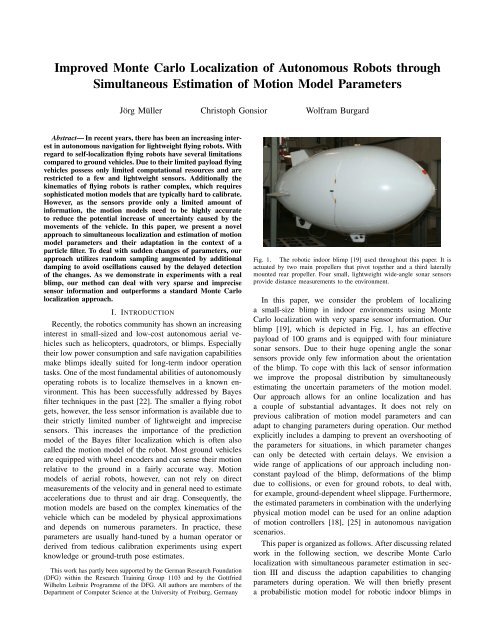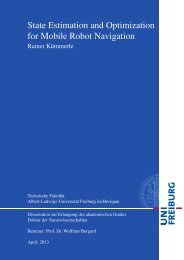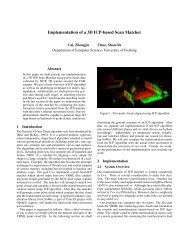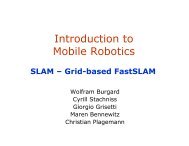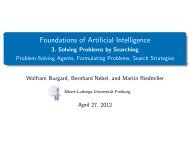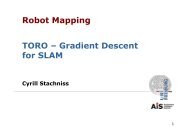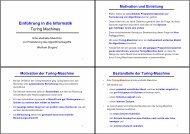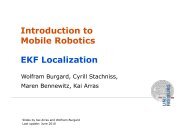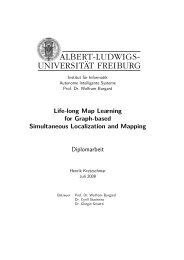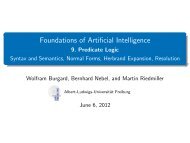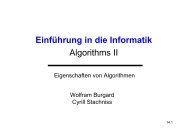Improved Monte Carlo Localization of Autonomous Robots through ...
Improved Monte Carlo Localization of Autonomous Robots through ...
Improved Monte Carlo Localization of Autonomous Robots through ...
You also want an ePaper? Increase the reach of your titles
YUMPU automatically turns print PDFs into web optimized ePapers that Google loves.
<strong>Improved</strong> <strong>Monte</strong> <strong>Carlo</strong> <strong>Localization</strong> <strong>of</strong> <strong>Autonomous</strong> <strong>Robots</strong> <strong>through</strong><br />
Simultaneous Estimation <strong>of</strong> Motion Model Parameters<br />
Jörg Müller Christoph Gonsior Wolfram Burgard<br />
Abstract—In recent years, there has been an increasing interest<br />
in autonomous navigation for lightweight flying robots. With<br />
regard to self-localization flying robots have several limitations<br />
comparedtogroundvehicles.Duetotheirlimitedpayloadflying<br />
vehicles possess only limited computational resources and are<br />
restricted to a few and lightweight sensors. Additionally the<br />
kinematics <strong>of</strong> flying robots is rather complex, which requires<br />
sophisticated motion models that are typically hard to calibrate.<br />
However, as the sensors provide only a limited amount <strong>of</strong><br />
information, the motion models need to be highly accurate<br />
to reduce the potential increase <strong>of</strong> uncertainty caused by the<br />
movements <strong>of</strong> the vehicle. In this paper, we present a novel<br />
approach to simultaneous localization and estimation <strong>of</strong> motion<br />
model parameters and their adaptation in the context <strong>of</strong> a<br />
particle filter. To deal with sudden changes <strong>of</strong> parameters, our<br />
approach utilizes random sampling augmented by additional<br />
damping to avoid oscillations caused by the delayed detection<br />
<strong>of</strong> the changes. As we demonstrate in experiments with a real<br />
blimp, our method can deal with very sparse and imprecise<br />
sensor information and outperforms a standard <strong>Monte</strong> <strong>Carlo</strong><br />
localization approach.<br />
I. INTRODUCTION<br />
Recently, the robotics community has shown an increasing<br />
interest in small-sized and low-cost autonomous aerial vehicles<br />
such as helicopters, quadrotors, or blimps. Especially<br />
their low power consumption and safe navigation capabilities<br />
make blimps ideally suited for long-term indoor operation<br />
tasks. One <strong>of</strong> the most fundamental abilities <strong>of</strong> autonomously<br />
operating robots is to localize themselves in a known environment.<br />
This has been successfully addressed by Bayes<br />
filter techniques in the past [22]. The smaller a flying robot<br />
gets, however, the less sensor information is available due to<br />
their strictly limited number <strong>of</strong> lightweight and imprecise<br />
sensors. This increases the importance <strong>of</strong> the prediction<br />
model <strong>of</strong> the Bayes filter localization which is <strong>of</strong>ten also<br />
called the motion model <strong>of</strong> the robot. Most ground vehicles<br />
are equipped with wheel encoders and can sense their motion<br />
relative to the ground in a fairly accurate way. Motion<br />
models <strong>of</strong> aerial robots, however, can not rely on direct<br />
measurements <strong>of</strong> the velocity and in general need to estimate<br />
accelerations due to thrust and air drag. Consequently, the<br />
motion models are based on the complex kinematics <strong>of</strong> the<br />
vehicle which can be modeled by physical approximations<br />
and depends on numerous parameters. In practice, these<br />
parameters are usually hand-tuned by a human operator or<br />
derived from tedious calibration experiments using expert<br />
knowledge or ground-truth pose estimates.<br />
This work has partly been supported by the German Research Foundation<br />
(DFG) within the Research Training Group 1103 and by the Gottfried<br />
Wilhelm Leibniz Programme <strong>of</strong> the DFG. All authors are members <strong>of</strong> the<br />
Department <strong>of</strong> Computer Science at the University <strong>of</strong> Freiburg, Germany<br />
Fig. 1. The robotic indoor blimp [19] used <strong>through</strong>out this paper. It is<br />
actuated by two main propellers that pivot together and a third laterally<br />
mounted rear propeller. Four small, lightweight wide-angle sonar sensors<br />
provide distance measurements to the environment.<br />
In this paper, we consider the problem <strong>of</strong> localizing<br />
a small-size blimp in indoor environments using <strong>Monte</strong><br />
<strong>Carlo</strong> localization with very sparse sensor information. Our<br />
blimp [19], which is depicted in Fig. 1, has an effective<br />
payload <strong>of</strong> 100 grams and is equipped with four miniature<br />
sonar sensors. Due to their huge opening angle the sonar<br />
sensors provide only few information about the orientation<br />
<strong>of</strong> the blimp. To cope with this lack <strong>of</strong> sensor information<br />
we improve the proposal distribution by simultaneously<br />
estimating the uncertain parameters <strong>of</strong> the motion model.<br />
Our approach allows for an online localization and has<br />
a couple <strong>of</strong> substantial advantages. It does not rely on<br />
previous calibration <strong>of</strong> motion model parameters and can<br />
adapt to changing parameters during operation. Our method<br />
explicitly includes a damping to prevent an overshooting <strong>of</strong><br />
the parameters for situations, in which parameter changes<br />
can only be detected with certain delays. We envision a<br />
wide range <strong>of</strong> applications <strong>of</strong> our approach including nonconstant<br />
payload <strong>of</strong> the blimp, deformations <strong>of</strong> the blimp<br />
due to collisions, or even for ground robots, to deal with,<br />
for example, ground-dependent wheel slippage. Furthermore,<br />
the estimated parameters in combination with the underlying<br />
physical motion model can be used for an online adaption<br />
<strong>of</strong> motion controllers [18], [25] in autonomous navigation<br />
scenarios.<br />
This paper is organized as follows. After discussing related<br />
work in the following section, we describe <strong>Monte</strong> <strong>Carlo</strong><br />
localization with simultaneous parameter estimation in section<br />
III and discuss the adaption capabilities to changing<br />
parameters during operation. We will then briefly present<br />
a probabilistic motion model for robotic indoor blimps in
section IV and finally evaluate the improvements <strong>of</strong> our<br />
localization system with simultaneous parameter estimation<br />
in simulation and experiments with a real blimp.<br />
II. RELATED WORK<br />
In the past, several authors considered the problem <strong>of</strong><br />
localizing small flying vehicles. The majority <strong>of</strong> approaches,<br />
however, employed previously learned motion models. For<br />
example, Ko et al. [11] used the ground-truth estimates <strong>of</strong><br />
a motion capture system for tuning <strong>of</strong> the motion model.<br />
Our previous work [15] relies on vision-based ground-truth<br />
and uses additional IMU sensor information for localization.<br />
Acquiring the ground-truth data involves either expensive<br />
and bulky systems or lacks sufficient precision to infer highly<br />
accurate motion models.<br />
Several approaches have been proposed to improve the<br />
proposal distribution in <strong>Monte</strong> <strong>Carlo</strong> localization using information<br />
from sensors other than wheel encoders or control<br />
commands. For example, Thrun et al. [23] sample additional<br />
“dual” particles from the observation likelihood to improve<br />
the robustness <strong>of</strong> the system and to better recover from<br />
localization failures. Whereas this approach is very effective,<br />
sampling from the observation likelihood is computationally<br />
demanding for range sensors such as sonar or laser range<br />
finders. Consequently, sampling from the observation model<br />
was mainly used for vision-based localization. Grisetti et<br />
al. [6] matched laser range scans to improve proposals<br />
for wheeled robots operating on planar grounds. Later, a<br />
similar approach was applied together with IMU data to<br />
localize miniature quadrotors operating in 6 degrees <strong>of</strong><br />
freedom (DOF) [7], [9]. However, it is unclear whether small<br />
lightweight sensors such as three miniature wide-angle sonar<br />
sensors allow for such a scan matching approach.<br />
One <strong>of</strong> the first systems for <strong>Monte</strong> <strong>Carlo</strong> localization with<br />
online calibration <strong>of</strong> the motion model was developed by Roy<br />
and Thrun [20]. They incrementally update the calibration<br />
parameters for differential drive robots based on a maximum<br />
likelihood position estimate obtained by scan matching.<br />
However, their approach relies on the direct calculation <strong>of</strong><br />
parameters out <strong>of</strong> two consecutive pose estimates which is<br />
not possible for more sophisticated motion models such as<br />
those for blimps. The case <strong>of</strong> sudden changes <strong>of</strong> the models<br />
or their parameters due to failures or collisions <strong>of</strong> wheeled<br />
robots is addressed by Plagemann et al. [16], [17]. They<br />
extend the particle filter localization by motion models <strong>of</strong><br />
different complexity and use a parameter sampling similar<br />
to our approach. However, they assume an initially known<br />
model including its parameters and switch online between a<br />
finite number <strong>of</strong> models.<br />
Beside the <strong>Monte</strong> <strong>Carlo</strong> localization, Kalman filters are a<br />
popular technique for mobile robot localization. For example,<br />
Martinelli et al. [14] extend the state vector by additional<br />
parameters for odometry errors. However, motion models<br />
<strong>of</strong> flying vehicles typically are highly non-linear and our<br />
wide-angle sonar sensors are not suitable to use within a<br />
Kalman filter. In the context <strong>of</strong> localization <strong>of</strong> UAVs, Bryson<br />
and Sukkarieh [2] estimate the difference between IMU and<br />
Fig. 2. The extended dynamic Bayes network for localization <strong>of</strong> a mobile<br />
robot. It characterizes the evolution <strong>of</strong> controls u, states x, measurements<br />
z, and parameters <strong>of</strong> the motion model Θ.<br />
motion model prediction in an additional extended Kalman<br />
filter to update the model parameters and the IMU bias. In<br />
contrast to our approach this requires to update the model<br />
parameters directly based on the prediction error similar to<br />
Roy and Thrun [20].<br />
Some approaches utilize the expectation maximization<br />
algorithm to simultaneously localize a robot and adapt its<br />
motion model. For example, Eliazar and Parr [5] iterate<br />
between estimating the path <strong>of</strong> the robot and optimizing the<br />
parameters <strong>of</strong> the motion model. However, these approaches<br />
are not intended for online applications and require to quickly<br />
optimize the parameters <strong>of</strong> the motion model given a trajectory<br />
<strong>of</strong> the robot which is not the case, e.g., for more complex<br />
motion models <strong>of</strong> flying robots such as blimps. Kaboli et<br />
al. [10] use the Markov Chain <strong>Monte</strong> <strong>Carlo</strong> technique to<br />
learn sensor and motion model parameters from raw sensor<br />
and action data by sampling trajectories and parameters,<br />
which typically requires substantial computational resources.<br />
In contrast to these previous approaches, our approach<br />
provides an online estimation and adaptation <strong>of</strong> previously<br />
unknown parameters <strong>of</strong> a complex and potentially non-linear<br />
motion model in the context <strong>of</strong> localization with particle<br />
filters. Furthermore, compared to multiple model tracking<br />
systems our approach can deal better with very slow changes<br />
in the continuous parameter space.<br />
III. MONTE CARLO LOCALIZATION WITH<br />
SIMULTANEOUS PARAMETER ESTIMATION<br />
Throughout this paper, we consider the problem <strong>of</strong> estimating<br />
the 6-dimensional pose x = (x,y,z,φ,θ,ψ) <strong>of</strong><br />
a robot relative to a given map m using <strong>Monte</strong> <strong>Carlo</strong><br />
localization [3]. The key idea <strong>of</strong> this approach is to maintain<br />
a probability density p(x 1:t | z 1:t ,u 1:t ) <strong>of</strong> the trajectory x 1:t<br />
<strong>of</strong> the robot given all observations z 1:t and control inputs<br />
u 1:t up to time t.<br />
A. Simultaneous Parameter Estimation<br />
In the presence <strong>of</strong> unknown (and probably time-varying)<br />
parameters <strong>of</strong> the motion <strong>of</strong> the robot, the underlying Bayes<br />
network is extended as depicted in Fig. 2. Here, the additional,<br />
non-observable parameter nodes are highlighted in<br />
gray. Consequently, the full localization posterior is extended
to p(x 1:t ,Θ 1:t | z 1:t ,u 1:t ) which can be factorized to<br />
p(x 1:t ,Θ 1:t | z 1:t ,u 1:t ) = η · p(z t | x 1:t ,z 1:t−1 ,Θ 1:t ,u 1:t )<br />
· p(x 1:t ,Θ 1:t | z 1:t−1 ,u 1:t ) (1)<br />
using Bayes rule where η is a normalizer. We factorize the<br />
second conditional probability twice and obtain<br />
p(x 1:t ,Θ 1:t | z 1:t−1 ,u 1:t )<br />
= p(x t ,Θ t | x 1:t−1 ,Θ 1:t−1 ,z 1:t−1 ,u 1:t )<br />
· p(x 1:t−1 ,Θ 1:t−1 | z 1:t−1 ,u 1:t )<br />
= p(x t | x 1:t−1 ,Θ 1:t ,z 1:t−1 ,u 1:t )<br />
· p(Θ t | x 1:t−1 ,Θ 1:t−1 ,z 1:t−1 ,u 1:t )<br />
· p(x 1:t−1 ,Θ 1:t−1 | z 1:t−1 ,u 1:t ) . (2)<br />
Under the Markov assumption, (1) together with (2) can be<br />
simplified to<br />
p(x 1:t ,Θ 1:t | z 1:t ,u 1:t )<br />
= η · p(z t | x t )<br />
· p(x t | x t−1 ,Θ t ,u t )<br />
· p(Θ t | Θ t−1 ,x 1:t−1 ,z 1:t−1 )<br />
· p(x 1:t−1 ,Θ 1:t−1 | z 1:t−1 ,u 1:t−1 ) . (3)<br />
As in [22], we assume that future controls give no information<br />
about the current state <strong>of</strong> the robot.<br />
To implement this recursive filtering scheme, we use a particle<br />
filter [4] where a set M <strong>of</strong> weighted particles represents<br />
the current belief. Each particle represents a hypothesis <strong>of</strong> a<br />
robot pose and parameter vector. As the proposal distribution<br />
we use the motion model combined with the model <strong>of</strong> the<br />
parameter behavior<br />
π(x 1:t ,Θ 1:t | z 1:t ,u 1:t )<br />
= p(x t | x t−1 ,Θ t ,u t )<br />
· p(Θ t | Θ t−1 ,x 1:t−1 ,z 1:t−1 )<br />
· p(x 1:t−1 ,Θ 1:t−1 | z 1:t−1 ,u 1:t−1 ) , (4)<br />
which results in the importance weight<br />
w [i]<br />
t = p(x 1:t,Θ 1:t | z 1:t ,u 1:t )<br />
π(x 1:t ,Θ 1:t | z 1:t ,u 1:t )<br />
∝ p(z t | x t ) w [i]<br />
t−1 (5)<br />
<strong>of</strong> the i-th particle at time t.<br />
Assuming the parameters to be constant over time, the<br />
belief update (3) can be performed according to the following<br />
three alternating steps:<br />
1) In the prediction step, we draw for each particle a new<br />
particle according to the parameterized motion model<br />
p(x t | x t−1 ,Θ t ,u t ) given the action u t .<br />
2) In the correction step, we integrate a new observation<br />
z t by assigning a new weight w [i] to each particle<br />
according to the sensor model p(z t | x t ).<br />
3) In the resampling step, we draw a new generation <strong>of</strong><br />
particles from M (with replacement) such that each<br />
sample in M is selected with a probability that is<br />
proportional to its weight.<br />
Following Liu and West [12], we reduce the sample degeneracy/attrition<br />
by adding small random disturbances to<br />
the parameter vector <strong>of</strong> each sample during resampling.<br />
To prevent a loss <strong>of</strong> information in the parameter vector<br />
sampling we apply kernel smoothing<br />
Θ [i]<br />
t<br />
∼ N(aΘ [i]<br />
t−1 + (1 − a)Θ t−1,h 2 V t−1 ) , (6)<br />
where Θ t−1 and V t−1 are the mean and the covariance <strong>of</strong><br />
the parameter vector over the particle set at time t − 1. The<br />
constant factors a = 3γ−1<br />
2γ<br />
and h 2 = 1 − a 2 only depend on<br />
a discount factor γ, which we set to 0.95.<br />
B. Adaption to Changed Parameters<br />
∑ N<br />
i=1 p(z t | x [i]<br />
t ) averaged over all particles.<br />
In certain cases, we cannot assume the physical properties<br />
<strong>of</strong> the motion <strong>of</strong> the robot to be constant for the complete<br />
period <strong>of</strong> operation. For example, wear and tear, changed<br />
payload, collisions, low batteries, or even manual mounting<br />
<strong>of</strong> banner ads can change the behavior <strong>of</strong> the robot. Once<br />
the parameter vector has converged within the particle filter,<br />
an adaption to one or more changed parameters would<br />
take a large number <strong>of</strong> sampling steps or could simply be<br />
impossible.<br />
Fortunately, this problem can be solved in a similar way as<br />
the well-known “kidnapped robot” problem by sampling an<br />
appropriate number <strong>of</strong> the particles at random positions [22].<br />
We analogously cope with parameter changes by drawing the<br />
parameter vector Θ uniformly from the parameter space for<br />
those random samples. The proportion <strong>of</strong> random samples is<br />
determined by monitoring the probability <strong>of</strong> sensor measurements<br />
p = 1 N<br />
We adopt this technique from Gutmann and Fox [8] and<br />
extend the resampling by setting the parameter vector <strong>of</strong> each<br />
particle to a uniform sample with probability<br />
max<br />
(<br />
0,1 − p )<br />
short<br />
. (7)<br />
ν p long<br />
Here, p short and p long are short-term and long-term averages<br />
<strong>of</strong> the sensor likelihood updated by<br />
p short ← p short + α short (p − p short ) (8)<br />
p long ← p long + α long (p − p long ) (9)<br />
on each correction step with the exponential decay factors<br />
0 < α long ≪ α short ≤ 1. The parameter ν allows to adjust<br />
the level at which random samples are added. Thus, this<br />
approach only adds random samples if the short-term average<br />
<strong>of</strong> the sensor likelihood is less than ν the long-term average.<br />
However, the sole addition <strong>of</strong> random parameter samples<br />
does not yield superior results since the adaption to changed<br />
parameters does not start until the pose estimate is slightly<br />
displaced from the ground-truth caused by wrong parameters<br />
and the average observation likelihood is dropped. When<br />
random parameter samples are added, those particles which<br />
quickly correct the displacement will get a higher observation<br />
likelihood. This leads to an overshooting <strong>of</strong> the estimated<br />
parameter values and causes the parameter values to oscillate
for several time steps (see Fig. 5, left). We address this oscillation<br />
problem by defining a lower bound to the covariance<br />
h 2 V, so that the parameter vectors are sampled according to<br />
Θ [i]<br />
t<br />
∼ N(aΘ [i]<br />
t−1 + (1 − a)Θ t−1,<br />
h 2 ˜max(V t−1 ,ρ Θ t−1 Θ T t−1)) (10)<br />
where the ˜max-operator builds a pointwise maximum over<br />
the diagonal elements <strong>of</strong> the matrices and takes all other<br />
elements from the first argument. Here, ρ is the relative<br />
covariance bound. This damps the oscillation and allows for<br />
a lower localization error after the change <strong>of</strong> parameters.<br />
Furthermore, this approach better handles very slow changes<br />
<strong>of</strong> parameters which are typically not detected <strong>through</strong> a<br />
suddenly dropped observation likelihood.<br />
Combining these techniques enables an autonomous robot<br />
to simultaneously estimate previously unknown parameters<br />
<strong>of</strong> the motion model in an online fashion and to adapt to<br />
changed parameters during operation, which is especially<br />
important in case <strong>of</strong> sparse or imprecise sensor information.<br />
IV. PROBABILISTIC MOTION MODELS FOR MINIATURE<br />
AIRSHIPS<br />
The probabilistic motion model p(x t | u t ,x t−1 ) plays a<br />
crucial role in the prediction step <strong>of</strong> the particle filter and<br />
its proper design is essential for accurate and efficient state<br />
estimates. An inaccurate motion model would result in a<br />
wide-spread proposal distribution and increases the number<br />
<strong>of</strong> wasted particles which in turn decreases the efficiency<br />
<strong>of</strong> the filter. To define an accurate probabilistic model, we<br />
first create a deterministic physical model <strong>of</strong> our blimp and<br />
afterwards extend this model such that it also considers the<br />
sources <strong>of</strong> uncertainty.<br />
Miniature airships typically are not equipped with sensors<br />
directly measuring their motion such as wheel encoders<br />
found on most ground vehicles. Instead, their motion has<br />
to be estimated based on forces and torques acting on them.<br />
In the following, we summarize our physical motion model<br />
which is based on [25]. The state <strong>of</strong> the blimp is defined by<br />
its pose p = (x,y,z,φ,θ,ψ) T consisting <strong>of</strong> three Cartesian<br />
translation coordinates and three Euler angles. Accordingly,<br />
its velocity is v = (v x ,v y ,v z ,ω x ,ω y ,ω z ) T . The Newton-<br />
Euler equation <strong>of</strong> motion<br />
M dv<br />
dt = ∑ F external (11)<br />
couples the acceleration <strong>of</strong> the airship to the external forces<br />
and torques. Thereby, M is the rigid-body inertia matrix and<br />
the external forces are gravity, buoyancy, propelling forces,<br />
air drag forces, and fictitious forces. Except for the air drag<br />
forces, all constituent parts can be determined in a straightforward<br />
way [25]. In the case <strong>of</strong> our blimp (see Fig. 1)<br />
the hull cannot be approximated appropriately by a highly<br />
symmetrical ellipsoid. Furthermore, the rear fins have an<br />
additional stabilizing effect.<br />
In general, two different types <strong>of</strong> air drag forces can be<br />
distinguished: viscous resistance and quadratic drag. Since<br />
our blimp operates at velocities exceeding 1 m s<br />
having a<br />
Reynolds number R e ≈ 30,000, we can safely reduce<br />
the drag formula to the quadratic part. Consequently, we<br />
approximate the drag force and torque <strong>of</strong> the hull in an<br />
uncoupled way as<br />
F D,h = ( − D x v x |v x |, −D y v y |v y |, −D z v z |v z |,<br />
− D ′ xω x |ω x |, −D ′ yω y |ω y |, −D ′ zω z |ω z |) T . (12)<br />
Analogously, the drag force <strong>of</strong> each fin acts parallel to its<br />
normal and scales with its area and the fin drag coefficient<br />
D f . Due to symmetry we can set D y = D z , D ′ y = D ′ z, and<br />
D ′ x ≈ 0 so that the motion model depends on a vector <strong>of</strong><br />
four unknown parameters Θ = [D x ,D z ,D ′ z,D f ]<br />
In our first localization system [15], we used a blimp<br />
motion model with fixed parameters and learned those parameters<br />
from about 8 min recorded data <strong>of</strong> our blimp based<br />
on the reference trajectory T ∗ which was acquired using the<br />
camera integrated in the gondola <strong>of</strong> the blimp [21]. To find<br />
the parameter vector ˆΘ which minimizes the incremental<br />
prediction error <strong>of</strong> the motion model we evaluated 30,000<br />
uniformly sampled values and started a gradient descent<br />
minimization routine from the ten best random parameter<br />
vectors. As all <strong>of</strong> them converged to the same ˆΘ, we expect<br />
this to be the global minimum. These previously estimated<br />
parameters ˆΘ are not used for our proposed localization with<br />
simultaneous parameter estimation.<br />
The uncertainty <strong>of</strong> the motion model described above has<br />
basically three sources <strong>of</strong> uncertainty. Firstly, the applied<br />
physical model is only an approximation, and secondly,<br />
the estimated parameters are not guaranteed to be the true<br />
parameters due to imperfection <strong>of</strong> the reference trajectory<br />
and the minimization routine. While both <strong>of</strong> these are<br />
systematic errors, thirdly, there are statistical errors such as<br />
imperfect motor responses, wind, or numerical errors. In our<br />
localization system, we combine all three sources <strong>of</strong> error<br />
and sample an additive velocity from a multivariate Gaussian<br />
with zero mean. Its covariance was determined based on the<br />
remaining error <strong>of</strong> the parameter optimization routine.<br />
V. EXPERIMENTAL EVALUATION<br />
The <strong>Monte</strong> <strong>Carlo</strong> localization with simultaneous parameter<br />
estimation described above has been implemented and<br />
evaluated using simulation experiments and data acquired<br />
with a real indoor blimp. In our experiments, we consider<br />
the problem <strong>of</strong> position tracking, i.e., localization with a<br />
known initial pose. To address the particle depletion problem,<br />
the resampling step is only performed if the number <strong>of</strong><br />
effective particles [13] n eff = (∑ i (w[i] ) 2) −1<br />
drops below<br />
a threshold κ. In our experiments, this is set to half the<br />
number <strong>of</strong> particles. As a measure <strong>of</strong> localization error we<br />
used the Euclidean distance between the weighted average<br />
<strong>of</strong> all particles and the reference pose.<br />
A. Experiments with a real blimp<br />
We evaluated the improvement <strong>of</strong> the simultaneous parameter<br />
estimation in terms <strong>of</strong> localization error using a<br />
1.70 m long blimp [19] in a large indoor environment.<br />
The blimp is actuated by two main propellers that pivot
translational error [m]<br />
rotational error [degree]<br />
success rate<br />
1<br />
0.8<br />
0.6<br />
0.4<br />
30<br />
25<br />
20<br />
15<br />
10<br />
1<br />
0.8<br />
0.6<br />
0.4<br />
0.2<br />
0<br />
extended<br />
standard<br />
extended<br />
standard<br />
extended<br />
standard<br />
0 2000 4000 6000 8000 10000<br />
number <strong>of</strong> particles<br />
Fig. 3. The average RMS localization error and the success rate <strong>of</strong> the<br />
extended <strong>Monte</strong> <strong>Carlo</strong> localization with simultaneous parameter estimation<br />
compared to the standard localization with previously learned parameters <strong>of</strong><br />
the motion model. The error bars indicate the 5% confidence intervals over<br />
ten runs.<br />
together and a third laterally mounted rear propeller for yaw<br />
rotation. Four small, lightweight wide-angle sonar sensors<br />
provide distance measurements to the environment, which<br />
are probabilistically modeled as described in our previous<br />
work [15]. The experimental indoor environment has an area<br />
for flying <strong>of</strong> about 14×7 m 2 with a vertical space <strong>of</strong> 5 m and<br />
was mapped from 3D laser scans using multi-level surface<br />
maps [24]. To determine the localization error, we put visual<br />
markers onto the floor, which allow us to accurately calculate<br />
the pose <strong>of</strong> the vehicle using the camera integrated in the<br />
gondola <strong>of</strong> the blimp [1].<br />
In an extensive experiment <strong>of</strong> about 9 minutes <strong>of</strong> manually<br />
operated flight the blimp covered a distance <strong>of</strong> about 180 m.<br />
Since we did not use an IMU and the wide-angle sonar<br />
sensors provide hardly any information about the orientation<br />
<strong>of</strong> the blimp, the localization relies on an accurate prediction<br />
<strong>of</strong> the motion model. As can be seen in Fig. 3, the <strong>Monte</strong><br />
<strong>Carlo</strong> localization with simultaneous estimation <strong>of</strong> initially<br />
unknown parameters benefits from the improved proposal<br />
distribution. It resulted in a significantly lower rotational<br />
localization error compared to the results obtained using the<br />
implementation with previously learned (see section IV) and<br />
fixed parameters <strong>of</strong> the motion model. The estimate <strong>of</strong> the<br />
parameter vector typically converged within the first minute<br />
<strong>of</strong> the experiment. Although the dimensionality <strong>of</strong> the state<br />
estimation problem was increased by the four parameters, the<br />
localization success rate revealed that the number <strong>of</strong> particles<br />
required to reliably localize the blimp is substantially smaller<br />
using the simultaneous parameter estimation.<br />
Furthermore, we tested our localization system with simultaneous<br />
parameter estimation in a global localization<br />
szenario with initially unknown pose and motion model<br />
parameters. We carried out 10 runs with 5,000 particles<br />
each. Whereas the pose estimate typically converged within<br />
the first 10 seconds, it still took 1 minute to determine<br />
the parameters. Based on these experiments we expect that<br />
translational error [m]<br />
rotational error [deg]<br />
0.1<br />
0.09<br />
0.08<br />
0.07<br />
0.06<br />
0.05<br />
5<br />
4.5<br />
4<br />
3.5<br />
3<br />
2.5<br />
2<br />
0 0.05 0.1 0.15 0.2 0.25 0.3<br />
relative covariance bound<br />
Fig. 4. The average translational and rotational RMS localization error<br />
<strong>of</strong> a 10 minute localization experiment on simulation data. The error bars<br />
indicate the 5% confidence intervals over ten runs.<br />
our approach can also handle the kidnapped robot problem<br />
given an extension which can distinguish between parameter<br />
changes and kidnappings based on drops <strong>of</strong> the observation<br />
likelihood.<br />
B. Simulation <strong>of</strong> Changing Parameters<br />
To evaluate the capability <strong>of</strong> our localization system to<br />
adapt to changing parameters <strong>of</strong> the motion model, we<br />
performed a series <strong>of</strong> experiments on a simulated blimp<br />
using our deterministic motion model. The true poses were<br />
passed as observations to the localization system and their<br />
likelihood were modeled as a Gaussian distribution with high<br />
translational and low rotational precision (σ trans = 0.2 m,<br />
σ rot = 15 ◦ ).<br />
In an experiment <strong>of</strong> about 10 minutes <strong>of</strong> manually operated<br />
flight we evaluated different relative covariance bounds ρ in<br />
our localization system using 5,000 particles. Note that we<br />
experimentally tuned the parameters α short = 0.2, α long =<br />
0.01, and ν = 0.8 to obtain best results. Although we<br />
introduced only little noise to the velocity <strong>of</strong> the blimp during<br />
simulation, the parameter estimation during localization was<br />
a challenging task due to the correlation <strong>of</strong> the different<br />
parameters (see Fig. 5). Furthermore, estimating all parameters<br />
requires a certain spectrum <strong>of</strong> movements. For example,<br />
during the first seconds <strong>of</strong> our experiment the blimp was<br />
controlled to move forward only which resulted in a quick<br />
convergence <strong>of</strong> solely the drag coefficient D x .<br />
Fig. 4 presents the localization accuracy on the simulated<br />
data during which the parameters <strong>of</strong> the motion model were<br />
changed as depicted in Fig. 5. Both, the translational and<br />
rotational localization error are significantly lower for a<br />
relative covariance bound <strong>of</strong> ρ > 0.15 than without a lower<br />
bound (ρ = 0) <strong>of</strong> the covariance <strong>of</strong> the parameters.<br />
VI. CONCLUSIONS<br />
In this paper, we presented a novel approach to <strong>Monte</strong><br />
<strong>Carlo</strong> localization <strong>of</strong> autonomous robots with simultaneous<br />
estimation <strong>of</strong> the parameters <strong>of</strong> the motion model. In<br />
contrast to other approaches, our systems allows an online<br />
localization without prior knowledge <strong>of</strong> all motion model<br />
parameters and can adapt to changed parameters during<br />
operation. To avoid oscillations after parameter changes on<br />
systems, for which these changes can only be detected with a
20<br />
15<br />
10<br />
5<br />
0<br />
2<br />
1.5<br />
1<br />
0.5<br />
0<br />
4<br />
3.5<br />
3<br />
2.5<br />
2<br />
1.5<br />
1<br />
0.5<br />
0<br />
0.5<br />
0.4<br />
0.3<br />
0.2<br />
0.1<br />
0<br />
fin drag coefficient<br />
real value<br />
x drag coefficient<br />
real value<br />
y/z drag coefficient<br />
real value<br />
yaw drag coefficient<br />
real value<br />
0 100 200 300 400 500 600<br />
time [s]<br />
20<br />
15<br />
10<br />
5<br />
0<br />
2<br />
1.5<br />
1<br />
0.5<br />
0<br />
4<br />
3.5<br />
3<br />
2.5<br />
2<br />
1.5<br />
1<br />
0.5<br />
0<br />
0.5<br />
0.4<br />
0.3<br />
0.2<br />
0.1<br />
0<br />
fin drag coefficient<br />
real value<br />
x drag coefficient<br />
real value<br />
y/z drag coefficient<br />
real value<br />
yaw drag coefficient<br />
real value<br />
0 100 200 300 400 500 600<br />
time [s]<br />
Fig. 5. The parameter estimation <strong>of</strong> exemplary localization runs <strong>of</strong> the simulated blimp without covariance bounding (left) and with ρ = 0.2 (right). The<br />
area between the 2.5% and 97.5% quantiles <strong>of</strong> the estimated posterior is marked gray.<br />
certain delay, our approach includes an appropriate damping<br />
mechanism. In experiments carried out with a real blimp and<br />
in simulation, we demonstrated that our system significantly<br />
outperforms the standard <strong>Monte</strong> <strong>Carlo</strong> localization with<br />
previously learned parameters in terms <strong>of</strong> the localization<br />
accuracy and the number <strong>of</strong> particles needed.<br />
REFERENCES<br />
[1] M. Billinghurst and H. Kato. Collaborative augmented reality. Communications<br />
<strong>of</strong> the ACM, (7), 2002.<br />
[2] M. Bryson and S. Sukkarieh. Vehicle model aided inertial navigation<br />
for a UAV using low-cost sensors. InProc.<strong>of</strong>theAustralasianConf.on<br />
Robotics & Automation (ACRA), 2004.<br />
[3] F. Dellaert, D. Fox, W. Burgard, and W. Thrun. <strong>Monte</strong> carlo<br />
localization for mobile robots. In Proc. <strong>of</strong> the IEEE Int. Conf. on<br />
Robotics & Automation (ICRA), 1999.<br />
[4] A. Doucet. On sequential simulation-based methods for bayesian filtering.<br />
Technical report, Signal Processing Group, Dept. <strong>of</strong> Engeneering,<br />
University <strong>of</strong> Cambridge, 1998.<br />
[5] A.I. Eliazar and R. Parr. Learning probabilistic motion models for<br />
mobile robots. In Proc. <strong>of</strong> the Int. Conf. on Machine Learning, 2004.<br />
[6] G. Grisetti, C. Stachniss, and W. Burgard. Improving grid-based<br />
slam with rao-blackwellized particle filters by adaptive proposals and<br />
selective resampling. In Proc. <strong>of</strong> the IEEE Int. Conf. on Robotics &<br />
Automation (ICRA), 2005.<br />
[7] S. Grzonka, G. Grisetti, and W. Burgard. Towards a navigation system<br />
for autonomous indoor flying. In Proc. <strong>of</strong> the IEEE Int. Conf. on<br />
Robotics & Automation (ICRA), 2009.<br />
[8] J.-S. Gutmann and D. Fox. An experimental comparison <strong>of</strong> localization<br />
methods continued. In Proc. <strong>of</strong> the IEEE/RSJ Int. Conf. on Intelligent<br />
<strong>Robots</strong> and Systems (IROS), Lausanne, Switzerland, 2002.<br />
[9] R. He, S. Prentice, and N. Roy. Planning in information space for<br />
a quadrotor helicopter in a gps-denied environments. In Proc. <strong>of</strong> the<br />
IEEE Int. Conf. on Robotics & Automation (ICRA), 2008.<br />
[10] A. Kaboli, M. Bowling, and P. Musilek. Bayesian calibration for<br />
monte carlo localization. In Proc. <strong>of</strong> the National Conf. on Artificial<br />
Intelligence (AAAI), 2006.<br />
[11] J. Ko, D.J. Klein, D. Fox, and D. Haehnel. GP-UKF: Unscented<br />
kalman filters with gaussian process prediction and observation models.<br />
In Proc. <strong>of</strong> the IEEE/RSJ Int. Conf. on Intelligent <strong>Robots</strong> and<br />
Systems (IROS), 2007.<br />
[12] J. Liu and M. West. Combined parameter and state estimation in<br />
simulation-based filtering. In Arnaud Doucet, Nando de Freitas, and<br />
Neil Gordon, editors, Sequential <strong>Monte</strong> <strong>Carlo</strong> Methods in Practice,<br />
chapter 10. 2001.<br />
[13] J.S. Liu. Metropolized independent sampling with comparisons to<br />
rejection sampling and importance sampling. Statist.Comput., 6, 1996.<br />
[14] A. Martinelli, N. Tomatis, A. Tapus, and R. Siegwart. Simultaneous<br />
localization and odometry calibration for mobile robot. In Proc. <strong>of</strong> the<br />
IEEE/RSJ Int. Conf. on Intelligent <strong>Robots</strong> and Systems (IROS), 2003.<br />
[15] J. Müller, A. Rottmann, and W. Burgard. A probabilistic sonar<br />
sensor model for robust localization <strong>of</strong> a small-size blimp in indoor<br />
environments using a particle filter. In Proc. <strong>of</strong> the IEEE Int. Conf. on<br />
Robotics & Automation (ICRA), 2009.<br />
[16] C. Plagemann and W. Burgard. Sequential parameter estimation for<br />
fault diagnosis in mobile robots using particle filters. In Autonome<br />
Mobile Systeme 2005 (AMS). Springer, 2005.<br />
[17] C. Plagemann, C. Stachniss, and W. Burgard. Efficient failure detection<br />
for mobile robots using mixed-abstraction particle filters. In H.I.<br />
Christensen, editor, European Robotics Symposium 2006, volume 22<br />
<strong>of</strong> STAR Springer tracts in advanced robotics. Springer Verlag, 2006.<br />
[18] A. Rottmann, C. Plagemann, P Hilgers, and W. Burgard. <strong>Autonomous</strong><br />
blimp control using model-free reinforcement learning in a continuous<br />
state and action space. In Proc. <strong>of</strong> the IEEE/RSJ Int. Conf. on<br />
Intelligent <strong>Robots</strong> and Systems (IROS), 2007.<br />
[19] A. Rottmann, M. Sippel, T. Ziterell, W. Burgard, L. Reindl, and<br />
C. Scholl. Towards an experimental autonomous blimp platform. In<br />
Proc. <strong>of</strong> the European Conf. on Mobile <strong>Robots</strong> (ECMR), 2007.<br />
[20] N. Roy and S. Thrun. Online self-calibration for mobile robots. In<br />
Proc. <strong>of</strong> the IEEE Int. Conf. on Robotics & Automation (ICRA), 1999.<br />
[21] B. Steder, G. Grisetti, S. Grzonka, C. Stachniss, A. Rottmann, and<br />
W. Burgard. Learning maps in 3d using attitude and noisy vision<br />
sensors. In Proc. <strong>of</strong> the IEEE/RSJ Int. Conf. on Intelligent <strong>Robots</strong> and<br />
Systems (IROS), 2007.<br />
[22] S. Thrun, W. Burgard, and D. Fox. Probabilistic Robotics. MIT Press,<br />
2005.<br />
[23] S. Thrun, D. Fox, and W. Burgard. <strong>Monte</strong> carlo localization with<br />
mixture proposal distribution. In Proc. <strong>of</strong> the National Conf. on<br />
Artificial Intelligence (AAAI), 2000.<br />
[24] R. Triebel, P. Pfaff, and W. Burgard. Multi-level surface maps for<br />
outdoor terrain mapping and loop closing. In Proc. <strong>of</strong> the IEEE/RSJ<br />
Int. Conf. on Intelligent <strong>Robots</strong> and Systems (IROS), 2006.<br />
[25] J.C. Zufferey, A. Guanella, A. Beyeler, and D. Floreano. Flying over<br />
the reality gap: From simulated to real indoor airships. <strong>Autonomous</strong><br />
<strong>Robots</strong>, 21(3), 2006.


